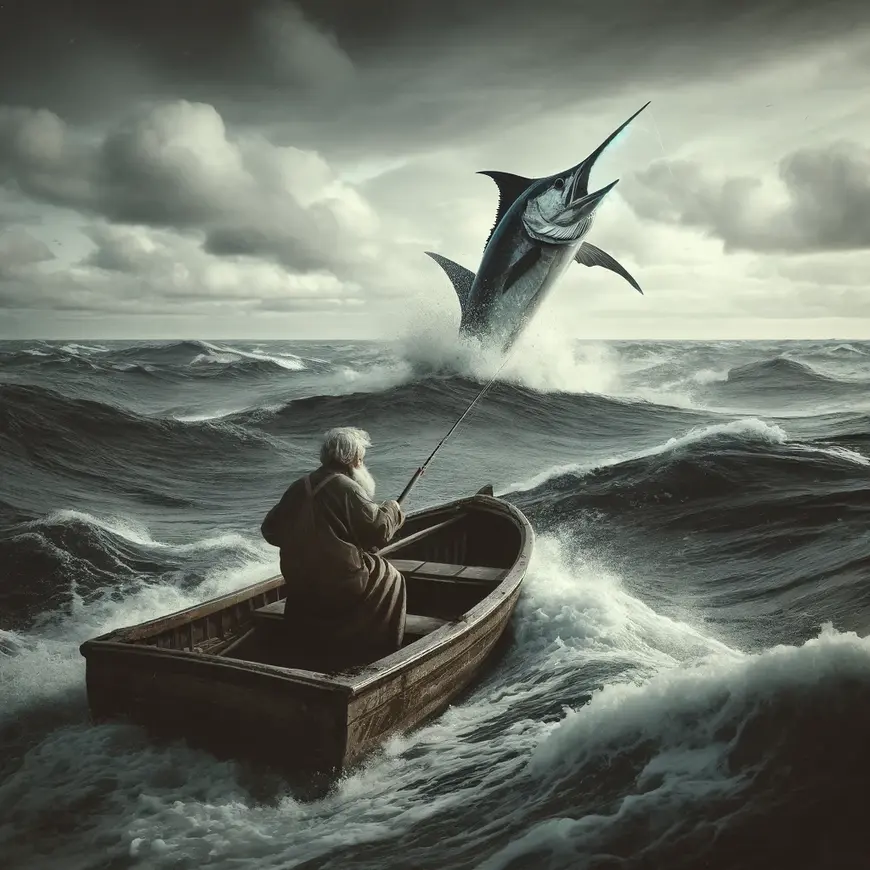A Timeless Tale of Resilience and Redemption: Ernest Hemingway’s “The Old Man and the Sea”
Ernest Hemingway, one of the greatest American writers of the 20th century, crafted a profound and introspective novella with “The Old Man and the Sea.” First published in 1952, this captivating work transports readers to the vast expanse of the sea, where an aging fisherman named Santiago embarks on a relentless battle against nature and himself. In this review, we will explore the mesmerizing narrative, Hemingway’s distinct writing style, and the enduring themes of determination and the human spirit that make “The Old Man and the Sea” an undisputed classic.
Unveiling the Tale of Perseverance:
“The Old Man and the Sea” tells the story of Santiago, an aging Cuban fisherman who has gone 84 days without catching a single fish. Undeterred by his streak of bad luck, Santiago sets out on what seems to be a fateful journey into the deep sea, determined to prove his worth and reclaim his former glory.
As Santiago faces the vastness and unpredictability of the ocean, he becomes entangled in a relentless struggle with a colossal marlin—a battle that pushes him to the limits of physical and mental endurance. Hemingway’s masterful portrayal of Santiago’s solitary journey captures the essence of the human spirit, highlighting the indomitable will to overcome adversity and the pursuit of personal triumph.

Hemingway’s Simple and Evocative Prose:
One of Hemingway’s trademarks is his unique writing style characterized by simplicity, precision, and sparse use of words. In “The Old Man and the Sea,” this distinctive prose elevates the narrative, transporting readers to the heart of Santiago’s struggle while leaving room for personal interpretation.
The author’s concise descriptions evoke vivid imagery, immersing readers in the world of the old fisherman and the vastness of the sea. Hemingway’s ability to capture the nuances of human emotions and the raw beauty of nature with such economy of language is a testament to his mastery as a writer. The stripped-down prose enhances the emotional impact of the story, making every word count in the portrayal of Santiago’s journey.
Themes of Resilience and Redemption: “The Old Man and the Sea”
At its core, “The Old Man and the Sea” is a profound exploration of resilience, determination, and the quest for personal redemption. Santiago’s relentless pursuit of the marlin reflects the human spirit’s capacity to persevere in the face of seemingly insurmountable challenges. The physical and mental strength he exhibits in the midst of his solitary struggle is a testament to the unwavering resolve of the human soul.
Hemingway also delves into the theme of redemption, as Santiago seeks to prove his worth and regain his dignity. Through the character of the old fisherman, the novella explores the inherent worth of an individual beyond external achievements. Santiago’s battle with the marlin becomes a metaphor for his personal journey of self-discovery and redemption, transcending the mere act of fishing.
Symbolism and Allegory:
“The Old Man and the Sea” is replete with rich symbolism and allegorical elements that invite readers to delve deeper into its meaning. The marlin, representing Santiago’s worthy opponent, embodies both the elusive nature of success and the adversities that test one’s character. The struggle between Santiago and the marlin parallels the larger struggles of life—man’s ongoing battle against the forces of nature, his own limitations, and the inexorable passage of time.
The presence of Manolin, the young boy who admires and supports Santiago, adds a touch of warmth and humanity to the story. Manolin’s unwavering loyalty symbolizes the power of friendship and the intergenerational bonds that transcend age and circumstance.
Famous Quotes from “The Old Man and the Sea” by Ernest Hemingway
- “But man is not made for defeat. A man can be destroyed but not defeated.”
- This quote captures the indomitable spirit of Santiago, the old fisherman, and the central theme of the novel: the battle between man and nature, and man’s resilience in the face of overwhelming odds. It speaks to the idea that while external forces can physically harm or even kill a person, they cannot crush his will or spirit unless he allows them to.
- “The sea is my brother, but sometimes it behaves like an enemy.”
- Santiago sees the sea as both a provider and a challenger. This duality reflects his respect and intimate knowledge of the natural world, acknowledging that it can be both nurturing and brutal. The sea symbolizes life itself, which can be supportive and sustaining at times, yet harsh and unforgiving at others.
- “Pain does not matter to a man.”
- Santiago says this as he endures physical suffering while struggling to catch the giant marlin. This quote underscores his stoicism and determination, emphasizing the theme of enduring physical and emotional pain in pursuit of one’s goals. It reflects Hemingway’s admiration for characters who show grit and perseverance in the face of adversity.
- “There is no one worthy of eating him from the manner of his behavior and his great dignity.”
- Here, Santiago reflects on the marlin he has caught, recognizing the fish’s noble struggle and seeing it as a worthy opponent. This quote highlights the theme of respect for nature and the bond between the hunter and the hunted. Santiago sees the marlin not just as a fish but as a fellow creature with its own dignity.
- “He was an old man who fished alone in a skiff in the Gulf Stream and he had gone eighty-four days now without taking a fish.”
- This opening line of the novel sets the stage for Santiago’s epic struggle. It speaks to the themes of loneliness, determination, and the inevitable passage of time. Despite his bad luck, Santiago continues to fish, demonstrating his unyielding resolve and commitment to his way of life.
- “It is better to be lucky. But I would rather be exact. Then when luck comes you are ready.”
- Santiago reflects on the importance of preparation and skill over relying solely on luck. This quote underlines the value of hard work, knowledge, and precision in achieving one’s goals. It suggests that while luck may play a role in success, being prepared and skilled allows one to fully capitalize on opportunities when they arise.

Trivia Facts about “The Old Man and the Sea”
- Last Major Work: “The Old Man and the Sea” was the last major work of fiction written by Hemingway published during his lifetime. It was released in 1952, and Hemingway won the Nobel Prize in Literature in 1954, partly due to the acclaim this novella brought him.
- Pulitzer Prize: In 1953, “The Old Man and the Sea” was awarded the Pulitzer Prize for Fiction. The award cited its powerful and enduring narrative as a significant factor for the accolade.
- Inspiration for the Story: The story was inspired by Hemingway’s experiences in Cuba, where he lived for periods of time from the 1930s. The character of Santiago was likely based on local fishermen Hemingway knew, melding their traits and his observations into the story’s protagonist.
- A Return to Form: Before “The Old Man and the Sea,” Hemingway had not published a major successful work for nearly a decade. The novella was seen as a return to form for Hemingway, showcasing his unmatched skill in storytelling and prose.
- Life Magazine Feature: Shortly after its publication, the novella was featured in Life magazine, which printed it in its entirety in a September 1952 issue. This publication was incredibly successful, selling over 5 million copies in just two days.
- Film Adaptations: “The Old Man and the Sea” has been adapted into films and television movies multiple times. The most notable adaptation is the 1958 film starring Spencer Tracy as Santiago, which won an Academy Award for Best Music, Scoring of a Dramatic or Comedy Picture.
- Symbolic Depth: The novella is rich in symbolism, with interpretations ranging from Christian allegory to a meditation on the relationship between humans and nature. The character of Santiago symbolizes the human condition, the marlin represents the ultimate challenge or goal, and the sea is seen as the setting of life’s trials and tribulations.
- Critical and Commercial Success: Despite its brevity, “The Old Man and the Sea” was both a critical and commercial success, demonstrating Hemingway’s ability to tell a compelling story with minimalism and precision. It helped to cement his legacy as one of the greatest writers of the 20th century.
- Hemingway’s Writing Style: The novella is a prime example of Hemingway’s distinctive writing style, known as the Iceberg Theory or the theory of omission. Hemingway believed in the power of understatement and the importance of leaving things unsaid, allowing the reader to fill in the emotional depth and meaning of the story.
- A Testament to Perseverance: Beyond its literary achievements, “The Old Man and the Sea” serves as a testament to the human spirit’s resilience and perseverance in the face of daunting challenges, echoing Hemingway’s own life and his enduring influence on literature.
A Timeless Classic: “The Old Man and the Sea”
“The Old Man and the Sea” continues to captivate readers and inspire generations with its timeless themes and profound storytelling. Hemingway’s ability to weave a poignant tale of human strength and the pursuit of meaning resonates with readers across cultures and eras.
In conclusion, Ernest Hemingway’s “The Old Man and the Sea” is a literary gem that embodies the resilience of the human spirit. Through its evocative prose, powerful themes, and enduring symbolism, the novella invites readers to reflect on the timeless values of determination, redemption, and the indomitable will to overcome adversity. Santiago’s solitary battle against the marlin serves as a reminder of the beauty and complexity of the human experience, leaving an indelible mark on the hearts of those who embark on this literary journey.